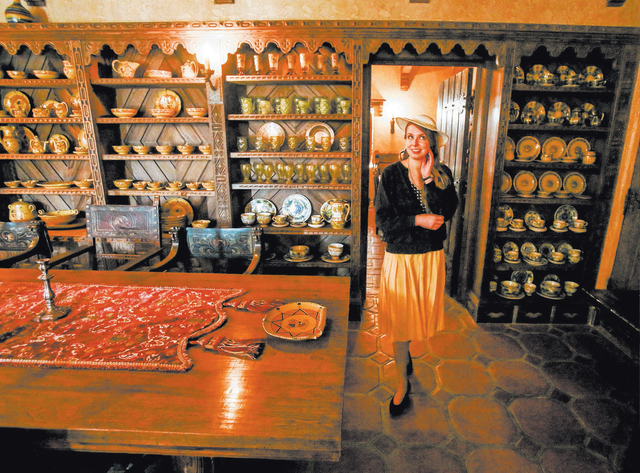Scotty’s Castle built on foundation of tall tales

Springtime is always a fine season in Death Valley National Park, but this spring is special with a good showing of wildflowers that began in February after a winter of frequent rains and an early heat wave.
Now the spring flower show is moving up into the canyons. Visitors approaching the park from the north are enjoying abundant blossoms through Daylight Pass from Beatty into the park and through Grapevine Canyon, the location of Scotty’s Castle, one of Death Valley’s most popular attractions.
Scotty’s Castle is about 150 miles from Las Vegas. Follow Highway 95 north through Beatty to Scotty’s Junction. Turn south on state Route 267 toward Death Valley and drive 26 miles to reach the mansion, once the headquarters of Death Valley Ranch. The park entrance fee is $20.
Scotty’s Castle has been attracting attention to northern Death Valley for more than 90 years. Curious visitors, including hordes of reporters, braved the desert’s heat and primitive roads to reach the ranch in Grapevine Canyon, where a luxurious Spanish and Mission Revival mansion began to rise in the early 1920s. Building materials were brought to the site by trucks from a siding on the Tonopah and Tidewater Railroad.
Questions about who owned the house existed for a long time because of tall tales told by Walter Scott, a colorful character better known as Death Valley Scotty. In truth, Scotty never owned the place, but he was friends with the wealthy owners, Albert and Bessie Johnson of Chicago.
The Johnsons made sure that the old rascal would always have a place to live, cared for by a charity that they left their money to in the 1940s. Scotty died in 1954 and is buried on the ranch property.
Death Valley Scotty had moved west from Kentucky as a boy and became a cowboy in the late 1800s. He had a stint with Buffalo Bill’s Wild West Show before taking up prospecting in California in the early 1900s. Always a storyteller, he dreamed up a tale of a gold mine in Death Valley and conned wealthy investors for support, among them Albert Johnson.
When Johnson insisted on visiting the gold mine, Scotty took him on a rambling trip into Death Valley. The dry climate, clean desert air and outdoor living helped Johnson’s health improve. He fell for Death Valley and became friends with the rapscallion who had bilked him. Soon, Johnson’s wife began tagging along on his trips to Death Valley, and they made plans to acquire land and build a second home there. Construction started in 1922 and continued well into the 1930s, but the mansion was never finished. The National Park Service purchased the site from the charity in 1970.
Scotty’s Castle is a day-use attraction, open daily. The grounds are open from 8 a.m. to 4 p.m. The park service visitor center is open from 9:45 a.m. to 3:45 p.m. Inquire there about a brochure for a self-guided tour of the grounds. The book and gift shop inside the center sell beverages and snacks, but visitors should pack a picnic lunch and plan to tailgate or use picnic tables on-site.
Three guided tours are available. The popular living history tour led by rangers in 1930s garb spends about an hour inside the house. The underground tour reveals hidden engineering that ran the house systems using water and solar power. The third tour visits Death Valley Scotty’s nearby house at Lower Vine Ranch. Tour sizes are limited and there may be long wait times. Check out the visitor center displays and tour the grounds while you wait.
It’s best to make arrangements for tours at least 24 hours in advance at recreation.gov or by calling 877-444-6777. Tickets are also available at the visitor center on a first-come basis for same-day tours. Tickets for tours of the house interior and underground features cost $15 for adults and $7.50 for seniors, recreational pass holders and children ages 6 to 15. For the Lower Vine Ranch tour, adults pay $20 and all others pay $10. Wheelchair accessibility may be limited.
Margo Bartlett Pesek’s Trip of the Week column appears on Sundays.